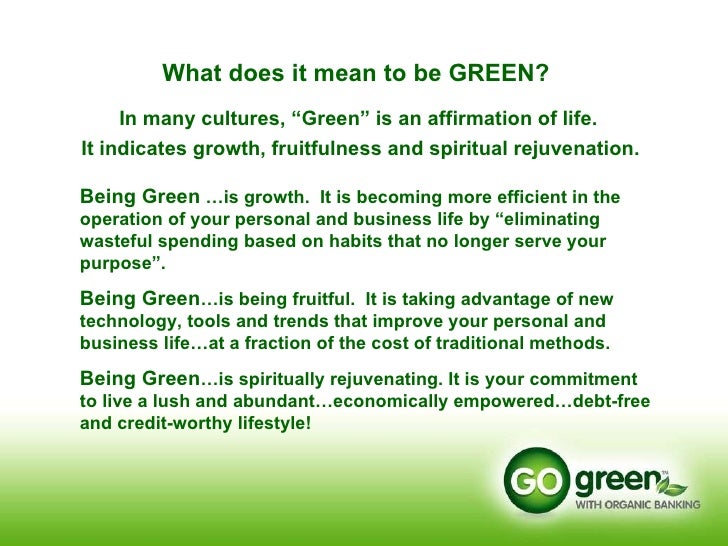Organic--What Does It Mean
Tuesday, March 27, 2018
Edit

Image source: https://image.slidesharecdn.com/gogreenpowerpointpresentation2-100606211520-phpapp02/95/go-green-power-point-presentation2-3-728.jpg?cb=1275859022
100% organic: must contain 100% organic materials. These products may add water and salt, however. Farms must not apply artificial chemicals to the plants for three years. That is not enough time for some chemicals to be released from the soil. These products may use the USDA seal.
Organic: must be 95% organic. The remaining 5% must come from a USDA approved list of 38 non-organic ingredients. For meat and poultry, the animals must be fed 100% organic feed. This designation does not regulate animal treatment. Often you might assume that such foods are free range, which could mean that there is a small door which is opened for 15 minutes a day and the animals have the option of going outside. It does not necessarily mean that Bessie and Chicken Little are frolicking in the fields. Foods labeled organic may use the USDA seal.
Made with Organic Ingredients: at least 70% of the ingredients are organic. The other 30% must come from a USDA approved list non-organic ingredients. These products may not use the USDA seal.
Foods with less than 70% organic ingredients may list those ingredients which are organic as organic in the ingredients list.
While its not popular yet, I hope to see biodynamic produce hit the shelves. This is more like the old-fashioned organic.
Why buy organic?
Its healthier. At the University of California Davis they grew organic and conventional kiwi in exactly the same environment. The organic plant produced fruit that had less flesh but more concentrated levels of minerals and higher amounts of ascorbic acid. It also didnt have all those toxins!
What about your budget?
Yes, organic tends to be more expensive. And there are also times when its hard to find organic (such as traveling). According to The Environmental Working Group, the following fruits and vegetables contain the highest concentration of pesticides:
Peaches
Apples
Sweet bell peppers
Celery
Nectarines
Raspberries
Strawberries
Cherries
Pears
Imported grapes
Spinach
Lettuce
Potatoes
And the following contain the lowest amount (so buying conventional might be okay):
Onions
Avocados
Pineapples
Mangoes
Kiwi
Asparagus
Broccoli
Cauliflower
Bananas
Cabbage
Corn (sweet)
Peas (sweet)
Papayas
When you cant get organic, buy local. Chances are it was picked that morning and fresher food has more available nutrients. One naturopath I know would rather have conventional, local, fresh fruit than organic came-from-another-state fruit. Choose what makes sense to you. Also consider the long term effects of eating conventional food: cancer, Parkinsons (which has been linked to pesticides) and other long-term, terminal illnesses. Can you really afford NOT to eat organic most of the time?
While some major food chains can be expensive, you can usually find roadside stands from roughly May to October. Talk to the farmers (who often are the very sellers taking your money). Many follow organic practices even though they do not have the official seal. Becoming certified is expensive.
Another possibility is to join a Community Supported Agriculture (CSA) group. CSAs are farms that grow and distribute food to those who buy a share. Some allow half-shares or have different sized shares depending on your family size. Some have pick-up points, some deliver. Some allow you to choose what will be in your share, others not. If you are a 100% raw food consumer you may elect to compost or give away your potatoes and eggplants. Heres where to learn about CSAs in your area: http://www.localharvest.org/csa/
Happy eating!
(c) 2007 Sharon Greenspan All Rights Reserved